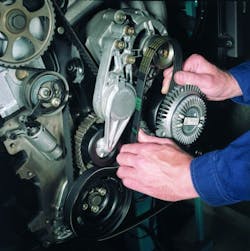The correct time to change a timing belt in older cars depends not only on the mileage of the car, but also on the age of the belt, says the ContiTech Power Transmission Group.
"Long periods of inactivity place just as much strain on a belt as regular operation,” says Helmut Engel, head of the group's Automotive Aftermarket Division. "Aging damages the material of chloroprene belts -- no matter how much you drive.
"Many drivers don't realize that just because your owner’s manual says you should make a regular trip to the repair shop, many cars are unlikely to reach the replacement intervals specified by the manufacturer, even after many years of driving.”
Manufacturers have started to change replacement intervals to take age into account, especially for timing belts, according to Roger Homer, ContiTech’s director of North America business development.
"However, these changes are not always indicated in the service manual. In order to perform maintenance in accordance with the inspection guidelines, repair shops should always refer to up-to-date information.”
If the manufacturer has not provided suitable specifications, ContiTech advises that timing belts used in older cars be replaced after six years at the latest. ContiTech offers products for this task, including OEM-quality kits containing perfectly matched drive components.
“When changing belts, it is also highly recommended to replace all the relevant belt drive components at the same time,” says Homer. “This provides greater safety for the engine.
"The advantages for service shops are clear: There is no need to order individual parts, you can always be certain that the parts match the vehicle and type, and administration for incoming goods and processing becomes a lot simpler.”
Using kits also provides mechanics with the best possible means of protecting themselves from possible warranty claims.
ContiTech is a division of Continental AG. For more information, visit www.contitech.de.



